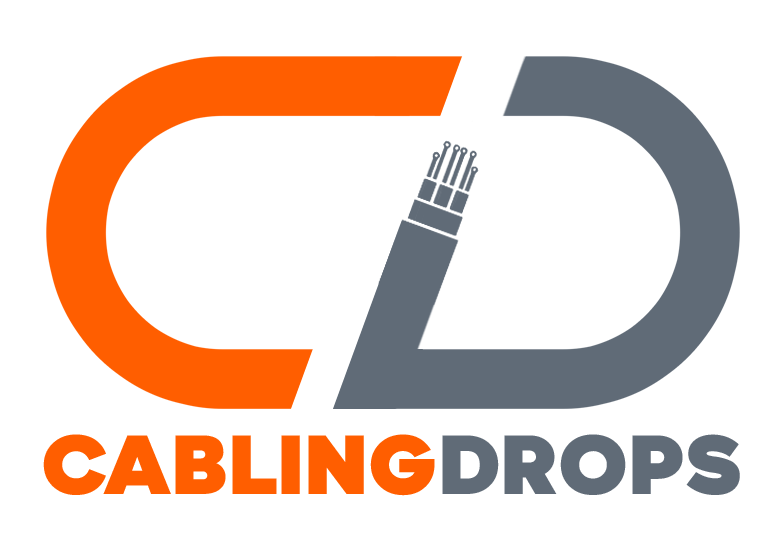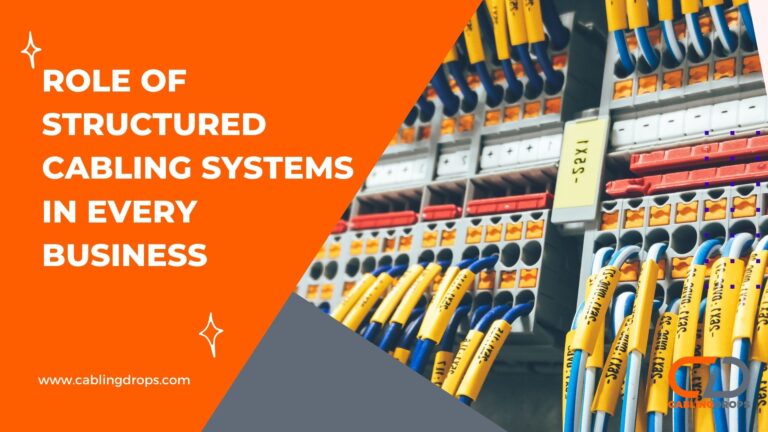
Businesses of all sizes rely heavily on strong, dependable, and effective communication networks in today’s hyperconnected world. Every contemporary IT infrastructure’s foundation is its cabling, which supports everything from data transfer to phone and video conferencing. Structured cabling systems are essential to guarantee smooth network operation and communication. For companies wishing to modernize their network infrastructure, this blog explores the fundamentals of structured cabling and its uses, advantages, and prospects for fiber optic networking.
What is Structured Cabling?
Structured cabling is a uniform method of building a network’s cabling infrastructure that can accommodate various hardware applications and is intended to make network management simple and highly organized. The smaller, standardized components that make up this cabling system are referred to as subsystems, and they include:
Entrance Facilities: Where the external service provider’s network connects to the internal system.
Equipment Rooms: Housing main distribution frames and other centralized equipment.
Backbone Cabling: Providing interconnections between entrance facilities, equipment rooms, and telecommunication closets.
Horizontal Cabling: Connecting telecommunications rooms to individual outlets on the floor.
Telecommunications Rooms: Where the horizontal cabling connects to the backbone cabling.
Work Area Components: Connecting end-user devices to outlets.
Structured cabling solutions offer a unified and consistent approach to network design and deployment. By adhering to these subsystems, they guarantee excellent performance and scalability.
What is Structured Cabling Used For?

In a commercial setting, structured cabling systems facilitate several types of communication and data transfer. These frameworks are essential for:
Supporting Data, Voice, and Video Communication
Structured cabling is the foundation of business communication networks. It facilitates voice, video, and data transfers and guarantees fast, dependable communication channels, whether connecting office computers, external cloud services, or VoIP systems.
Enhancing Network Performance and Reliability
A well-designed structured cabling system improves network performance by lowering latency, minimizing signal interference, and offering quicker data transfer rates. Standardized and well-organized wiring design reduces the chance of mistakes and downtime, increasing reliability.
Facilitating Easy Integration of New Technologies
Structured cabling makes it possible for new technologies to be seamlessly integrated as businesses expand and technology advances. Because of its flexibility, the network can accommodate new technologies without completely revamping its current setup.
Top Benefits of Structured Cabling
Businesses can benefit much from investing in a structured cabling infrastructure, including:
Scalability
Scalability is one of the main advantages of structured cabling. As organizations expand and their network requirements change, increased data traffic, and more devices can be added to a structured cabling system. Structured cabling’s modular nature makes it simple for organizations to grow, allowing them to add new components without redesigning the network entirely. This scalability can give firms a significant competitive edge and is crucial for those who need to quickly adjust to shifting technology demands.
Reduced Downtime
Businesses can suffer significantly from downtime, resulting in lost output, missed opportunities, and lower customer satisfaction. Structured cabling systems reduce downtime by offering a more dependable and well-organized network infrastructure. By using clearly defined paths and standardized connections, structured cabling lowers the possibility of errors and facilitates rapid problem diagnosis and resolution.
Cost-Effectiveness
The long-term cost advantages of a structured cabling system outweigh any potential greater initial investment relative to more conventional cable techniques. Structured cabling systems increase network efficiency, decrease maintenance expenses, and rarely require expensive repairs and upgrades. By offering a more dependable and scalable network infrastructure, structured cabling helps companies save money over time and get a better return on investment.
Improved Network Performance
Structured cabling systems, which offer dependable, fast connections, improve network performance overall. These systems guarantee speedy and precise data transmission, enhancing user happiness and productivity by reducing interference and latency. Because even minor delays can significantly affect operations, this is especially crucial for companies that depend on real-time data processing and transmission.
Simplified Management
Structured cabling’s uniformity and organization simplify network management, facilitating easier network maintenance and troubleshooting for IT personnel. IT workers can find and fix problems more quickly with standardized connections and well-defined channels, which cuts down on the time needed for upkeep and repairs. This minimizes the impact on business operations by ensuring that any disruptions are promptly handled and also increases the overall uptime of the network.
Fiber Optic Structured Cabling Systems: The Future of Networking
Fiber optic structured cabling systems are becoming increasingly common as the need for faster and more dependable network connections grows. Fiber optics are a great option for companies wishing to future-proof their network infrastructure since they provide several benefits over conventional copper wiring. Fiber optic cabling offers the performance and dependability required to support contemporary commercial applications and technologies, from increased bandwidth to longer-distance capabilities.
Higher Bandwidth: Fiber optic connections are perfect for high-demand applications because they transport far more data than copper cables.
Greater Distance: Fiber optics can transmit data over longer distances without signal degradation, making them suitable for large campuses and multi-building installations.
Immunity to Electromagnetic Interference: Optic cables are immune to electromagnetic interference, making them more solid and dependable than copper cables in terms of connectivity.
Future-Sealing: Fiber optic cabling is a future-proof technology that can handle the rising needs of contemporary networks, given the growing requirement for faster data transfer speeds.
Tips for Designing a Structured Cabling System
Careful planning and consideration of the following elements are necessary for the design of an efficient, structured cabling system:
Assess Current and Future Needs: Understand your network requirements and anticipate future growth to ensure the system can accommodate expansion.
Follow Standards: Adhere to industry standards such as TIA/EIA-568 to ensure compatibility and performance.
Plan for Redundancy: Include redundant pathways and connections to enhance network reliability and reduce downtime.
Use Quality Components: Invest in high-quality cables, connectors, and other components to ensure longevity and performance.
Consider Environmental Factors: When designing the system, account for environmental conditions such as temperature, humidity, and electromagnetic interference.
Document Everything: Maintain detailed documentation of the cabling layout, including diagrams and labeling, to simplify management and troubleshooting.
Upgrade Your Network with Cabling Drops Today!
A structured cabling system purchase is an essential step for companies trying to improve their networks’ scalability, dependability, and performance. Structured cabling offers a reliable and adaptable infrastructure to meet your company’s demands, whether planning a new installation or updating an old network. By adhering to industry standards and best practices, you can establish a network that satisfies your present needs and facilitates expansion in the future.
At Cabling Drops, our expertise lies in creating and implementing superior structured cabling solutions tailored to your company’s requirements. Our skilled team of experts is committed to offering specialized solutions that improve network dependability and performance. Contact us today to learn more about our services and how we can help you upgrade your network.
FAQs
What is the process of structured cabling installation?
The installation process for structured cabling involves several steps:
Planning and Design: Assess the network requirements, create a detailed design, and plan the layout.
Cabling Installation: Install cables, connectors, and hardware according to the design plan.
Termination and Testing: Terminate cables at both ends, connect them to devices, and perform thorough testing to ensure proper functionality.
Documentation: Document the installation process, including cable routes, labels, and test results.
Certification: Obtain certification from an industry-standard organization to ensure compliance and performance.
What components make up a structured cabling system?
A structured cabling system comprises several key components:
Cabling: Copper or fiber optic cables that connect various network devices.
Connectors: Jacks, plugs, and other connectors terminate and connect cables.
Patch Panels: Panels that provide a centralized point for connecting and managing cables.
Racks and Cabinets: Housing for equipment and cables to keep them organized and secure.
Cable Management: Trays, ducts, and other accessories organize and protect cables.
What are the different types of structured cabling available?
There are several types of structured cabling systems, including:
Category 5e (Cat5e): Supports up to 1 Gbps over a distance of 100 meters.
Category 6 (Cat6): Supports up to 10 Gbps over a distance of 55 meters.
Category 6a (Cat6a): Supports up to 10 Gbps over a distance of 100 meters.
Category 7 (Cat7): Supports up to 10 Gbps with improved shielding and reduced interference.
Fiber Optic Cabling: Supports high-speed data transfer over long distances with minimal signal loss.
Why should a business consider a fiber optic structured cabling system?
Fiber optic structured cabling systems offer several benefits, making them an excellent choice for businesses:
Higher Bandwidth: Supports more excellent data transfer rates, accommodating high-demand applications.
Longer Distance: Transmits data over longer distances without signal degradation.
Immunity to Interference: Not affected by electromagnetic interference, ensuring stable connections.
Future-Proofing: Capable of supporting future technological advancements and increasing data demands.
How does structured cabling improve network reliability?
Structured cabling improves network reliability by providing an organized and standardized approach to cabling infrastructure. This reduces the likelihood of errors, minimizes signal interference, and ensures consistent performance.